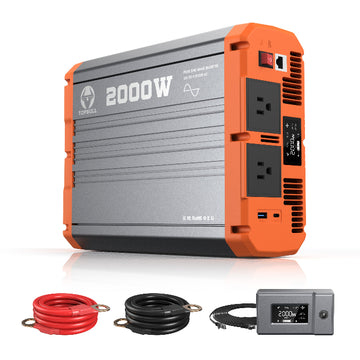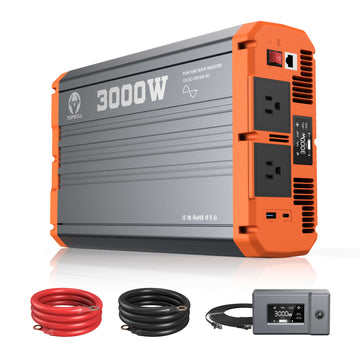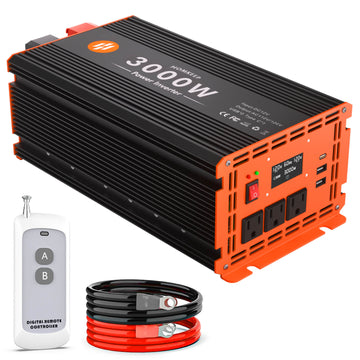Yes, some off-grid inverters can operate without batteries, but this depends on the system design, energy usage patterns, and backup power. Traditional off-grid inverters convert DC power stored in batteries to AC power. However, not all off-grid inverters have to work with batteries.
Batteryless off-grid inverter usage scenarios
Not all systems are suitable for batteryless off-grid inverters, but they excel in specific applications where daytime power generation perfectly matches energy demand.
Agricultural production
One of the most common applications for batteryless off-grid inverters is agricultural production, such as irrigation systems or livestock water pumps. Farmers often need high power to run their equipment during the day, and batteryless units can eliminate battery costs while directly converting solar energy into instant electricity.
Solar drip irrigation systems in remote areas can operate efficiently without the need for energy storage, reducing upfront costs by up to 40% compared to traditional battery-backed systems.
Temporary site
Another key scenario for batteryless off-grid inverters is temporary or mobile facilities such as construction sites, outdoor events, or remote research stations. These environments prioritize short-term daytime energy needs, such as powering tools, lighting, or communications equipment, without the logistical hassle of installing and maintaining batteries.
Contractors often pair batteryless inverters with portable solar panels to create a flexible, on-demand power source that can be moved as the project grows.
Incorporating grid-tie capabilities
Hybrid systems can also benefit from batteryless inverters when integrated with the grid or a backup generator. In areas where the grid is intermittent, batteryless solar inverters can provide power during the day and seamlessly switch to the grid or diesel generator at night. This approach minimizes reliance on fossil fuels during peak daylight hours and is ideal for small businesses or homes in areas with unstable utility infrastructure.
Disaster areas
Finally, batteryless inverters play a critical role in emergency and disaster relief. When rapid deployment is required, such as powering medical equipment in disaster areas or charging stations for disaster relief workers, a simplified batteryless solar installation can provide power immediately. These systems avoid the complexity of battery maintenance and focus on providing emergency power during critical daylight windows.
While these application scenarios highlight the versatility of batteryless systems, success depends on thoughtful load planning and backup integration. Battery storage remains the more reliable long-term solution for 24/7 continuous power.

Pros and cons of an off-grid inverter without a battery
For some users, choosing a batteryless, off-grid inverter offers distinct advantages, but there are also pros and cons to weigh. Below, we'll break down the main benefits and limitations of this setup to help you determine if it meets your energy goals.
Advantages of a batteryless inverter systems
1. Lower upfront and maintenance costs
The biggest benefit of not using batteries is the significant cost savings. Batteries typically make up 30-50% of the initial investment in an off-grid system, especially lithium-ion or advanced lead-acid batteries. By removing this component, the user avoids not only the purchase cost but also the ongoing costs of battery replacement and maintenance.
2. Simple installation and high reliability
Without batteries, the system becomes much easier to install and maintain. There is no need for battery ventilation systems, temperature-controlled enclosures, or complex energy storage wiring. This simplicity also means fewer points of failure - batteries are prone to degradation, overheating, or loss of capacity over time.
As long as the daily energy demand matches the hours of sunlight, solar-powered water pumps on remote farmland can operate reliably for years with minimal maintenance.
3. Enhanced environmental sustainability
Batteryless systems eliminate battery-related pollution and meet environmental goals. Conventional batteries involve resource-intensive manufacturing processes (e.g., lithium mining) and pose disposal challenges, as improper recycling can leach toxic chemicals into the soil and water.
Batteryless setups reduce carbon footprints and simplify end-of-life system management, making them ideal for environmentally conscious users or projects in ecologically sensitive areas.
Disadvantages of a batteryless inverter systems
1. Total dependence on sunlight
The obvious disadvantage of a battery-less inverter is its complete dependence on sunlight. With no energy storage, the system is unable to supply power at night or during extended periods of cloudy weather. This limitation makes it unsuitable for applications that require 24/7 power, such as residential lighting, refrigeration, or medical equipment.
Even hybrid systems that rely on a backup grid/generator may be at risk of power interruptions if the backup system fails or runs out of fuel, resulting in critical downtime.
2. Limited flexibility in energy management
Battery-free systems require rigorous load planning to avoid overloading inverters. Users must prioritize energy use during the day and manually adjust consumption - for example, by running high-wattage appliances such as air conditioners or welding tools only during peak daylight hours. This can disrupt workflows in commercial environments or homes where energy demand is unpredictable.
In contrast, battery-backed systems provide flexibility by storing surplus energy for later use, smoothing out peaks in demand.
3. Narrow range of possible applications
While battery-free inverters perform well in certain situations (e.g., daytime-only operation), they cannot support mainstream off-grid living. Most homes and businesses require continuous power outside of daytime hours, which requires a battery or grid connection. Even in hybrid configurations, the lack of storage limits a system's ability to take advantage of time-of-day power savings (e.g., using stored solar energy during peak electricity prices).
For example, rural clinics requiring nighttime lighting and cooling may find that a battery-free system is insufficient without a highly reliable backup generator.
Is a battery-free, off-grid inverter right for you?
Determining whether a battery-free, off-grid inverter is right for your needs depends on your energy consumption patterns, budget, and environmental conditions.
Daytime-centered energy demand
Battery-free systems are suitable for situations where energy use is consistent with daylight hours. For example, agricultural operations such as irrigation pumps or daytime workshops can benefit directly from solar power without the need for nighttime energy storage. In this case, the system can reduce upfront costs by 30-50% compared to a battery-backed setup.
However, if your activities require 24/7 power, such as residential lighting, refrigeration, or medical equipment, then such a setup would fall short of requirements due to its inability to store energy for use after sunset.
Budget constraints and long-term reliability
Cost savings are a major advantage. Not using batteries eliminates the cost of purchasing and replacing them.
However, in areas with frequent cloudy days or unstable backup grids, long-term reliability may suffer. Hybrid systems that minimize battery storage or grid connections provide a middle ground that balances economy and reliability.
Scalability and future flexibility
Battery-less systems are less adaptable to changing energy demands. Scaling up requires additional panels or inverters rather than simply expanding energy storage capacity.
Conclusion
Ultimately, the viability of a battery-free, off-grid inverter depends on your priorities. If your goal is to minimize costs, simplify maintenance, and meet specific energy needs during the day (e.g., irrigation, construction tools, or emergency operations during the day), then this setup can provide a practical solution.
However, for applications requiring uninterrupted power or flexibility, pairing an inverter with a small battery may provide better long-term value. Be sure to evaluate your daily power usage patterns, local climatic conditions, and backup options before going with a battery-free design.














